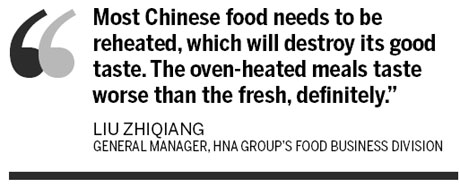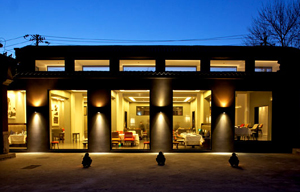Sky-high ambition on a plate
"The oven-heated meals taste worse than the fresh, definitely," Liu said. Oven-heated is even worse than the microwaved food.
But the microwave oven cannot be used a lot in the airplane, as it may interrupt the communication systems, he added.
Imperial Airways, the predecessor of British Airways, introduced meals on its flights in May 1927.
Chinese airlines prepare their meals following Western processes, which is not suitable for Chinese food, Liu said.
"Most Chinese food needs to be reheated, which will destroy its good taste," he said.
But airline food is set to improve, as food manufacturers are experimenting with normal-temperature processes to keep the meals fresh.
The life of meals, which will be irradiated through high temperature and pressure facilities, can be prolonged.
"But the facilities will cost a lot, therefore normal-temperature processes cannot be a popular method," Liu said.
The civil aviation industry has to consider cost, since the industry's margins have been dropping.
All Chinese airlines made 388.98 billion yuan ($63.56 billion) in revenue in 2012, a 9.1 percent year-on-year increase, but their total profit was only 21.1 billion yuan, decreasing by 6.21 billion yuan during the same period, according to the Civil Aviation Administration of China.
The drop in airline income also affects the meal manufacturers. E-food Group, which has seven in-flight meal factories across the country, received only 368.75 million yuan from the in-flight meal arm of their business in 2012, down 4.59 percent year-on-year, despite the group producing 10.39 percent more in-flight meals, according to its financial report.
"Some of the airlines cut backups and some of them just cut the whole budget directly," Liu said.
The civil aviation authority also released a new policy in January stating that flight attendants are only allowed to begin work 20 minutes after take off and must stop work 30 minutes before landing.
The new policy means flights under two hours in length no longer have time to serve meals.
In-flight meal manufacturers have to search for other ways to expand their business, although their market share is relatively stable.
The growing market in chartered business flights and budget airlines provides opportunities for in-flight meal providers.
"The business jet operators usually spend three to five times the price on the meal than the normal flights," said Ji Xingzhuo, chairman of Air Taxi (Hong Kong) Business Jet Co Ltd.
Beijing Air Catering Co Ltd supplies most of the meals in his jets, but sometimes he has to provide meals according to passengers' requests, which cost even more, he added.
But insiders said chartered business flights remain limited, and the in-flight meal manufacturers also have ambitions closer to the ground.
E-food Group, which has three companies supplying meals for high-speed trains, received 236.81 percent more income from the railway market in 2012 compared with 2011.
"High-speed rail is already an important client for us and the ground market, such as restaurants and some company canteens, are also our target," Liu said.
Beijing Air Catering, the subsidiary of China National Aviation Holding Group that has a 75 percent market share in the Beijing in-flight meal market, has already received business from some cafe chains, including Starbucks, Costa Coffee and Sculpting in Time.
But the in-flight meal manufacturers have developed quickly thanks to China's soaring air traffic in recent years.
Beijing Air Catering, which was established in 1980, has almost 1 billion yuan in assets and supplies meals for an average of 450 flights every day.
Beijing Xinhua Airport Catering Co Ltd, a subsidiary of HNA Group, the fourth largest airline group in China, also plans to double its workshop area. The company occupies 15 percent market share in Beijing.
"The plan is based on HNA Group's development strategy, since the group's airlines are our main clients," said Xu Hao, general manager of the company.
Beijing Air Catering and Xinhua Airport Catering represent the most important category of in-flight meal enterprises in China, which were invested directly by airlines.
There are also two other categories of air catering enterprises. One is associated with local airports and the other is totally independent.
Every airline has their own standard to choose meal suppliers, especially the foreign airlines.
"We do have requirements to choose our local providers abroad," said Thomas Brockenauer, Lufthansa's culinary expert for the Asian region.
Brockenauer said the airlines checked the quality of food, infrastructure such as human resources, trucks available and security, as well as hygiene standards.
"The budget is also important for the airline," he added.

Emirates Airlines, well known for its high standard of service, has strict processes to choose third-party suppliers.
"Suppliers are selected only after Emirates' catering management team has visited and evaluated premises for food product and hygiene standards: kitchens, purchasing, storage and handling of raw materials are all appraised," a spokesman from the carrier told China Daily.
The airline also evaluates its meal contractors at least every three months and they are generally renewed every three years to ensure quality and standards are maintained, he added.
The carrier's menus are planned for each individual route to make sure the meals are appropriate for the different destinations.
"Emirates ensures that the menu includes congees and Chinese dishes on flights from Dubai to Beijing or Shanghai," the spokesman said.
Three Chinese companies provide food to Emirates, Beijing Air Catering, Pudong International Airport Gate Gourmet Air Catering Co Ltd in Shanghai and LSG Sky Chefs in Guangzhou.
Although different manufacturers make the meals, the airlines are confident about their global unified standards.
"We are really sure the product and services that our caterers offer are always at very high, consistent, standard regardless of where the caterer is located," said Cathay Pacific, which has suppliers in Beijing and Shanghai.


















